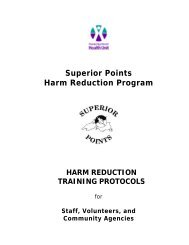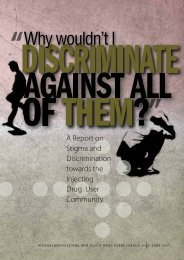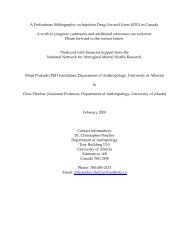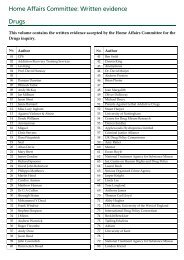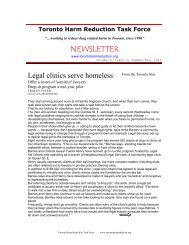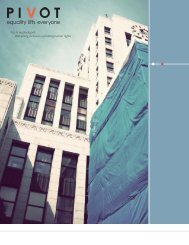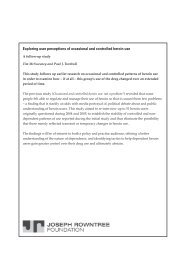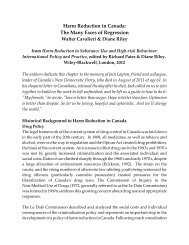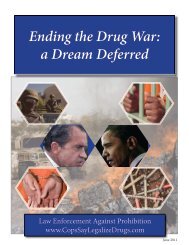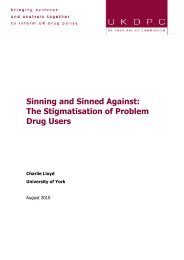The Incarceration of Drug Offenders - The Beckley Foundation
The Incarceration of Drug Offenders - The Beckley Foundation
The Incarceration of Drug Offenders - The Beckley Foundation
- No tags were found...
Create successful ePaper yourself
Turn your PDF publications into a flip-book with our unique Google optimized e-Paper software.
13Justice Studies found that “when you consider the impact on familiesand wider society, the estimated annual cost <strong>of</strong> imprisonment for anindividual rise by almost a third to nearly £50,000 (Solomon, 2008.)A high level <strong>of</strong> spending on incarceration naturally generatesopportunity costs to other areas <strong>of</strong> public expenditure. For example,research shows that in California and New York prison expenditureoutstripped the budgets for higher education during the mid-1990s(Schiraldi, Holman & Beatty, 2000). In the US as a whole between1987 and 1995 spending on corrections rose by 30%. On elementaryand secondary education spending fell by 1.2% and on higher educationby 18.2% (Stern, 1998). By 1999 many states in the US were spendingmore on building prisons than colleges (Irwin, Schiraldi & Ziedenberg,1999). <strong>The</strong> American sociologist, Elliot Currie concluded in 1993that funds for prisons were diverted from parts <strong>of</strong> the public sectorthat educate, train, socialize, treat, house and nurture the population,especially the children <strong>of</strong> the poor (Currie, 1994).Collateral Costs<strong>The</strong> wider costs produced by spending on prisons rather than schoolsand colleges are far from straightforward to calculate. It is likelythat the diversion <strong>of</strong> funds to prisons has a deleterious impact uponmany aspects <strong>of</strong> American society. It may even contribute to thecreation <strong>of</strong> social conditions that lead some people to use illicit drugs.<strong>The</strong>se social conditions, moreover, are overwhelmingly concentratedin demographic groups already afflicted by economic and socialdisadvantage.<strong>The</strong> influential work <strong>of</strong> criminologist David Garland has relevancehere; Garland uses the term “mass-imprisonment” (Garland, 2001)to describe the rates <strong>of</strong> incarceration which have developed in theUS over recent decades, leading to a situation in which poor andethnic minority citizens are much more likely to be imprisoned bythe state than was ever the case in the past. In this formulation, theeffects <strong>of</strong> high rates <strong>of</strong> imprisonment go beyond the individual andaffect members <strong>of</strong> entire demographic groups, membership <strong>of</strong> whichhas become strongly predictive <strong>of</strong> criminality and incarceration. Asobserved by Mary Pattillo et al: “...the criminal justice system hasbecome a fixture in the passage to adulthood for minority youth withlittle economic opportunity.” (Pattillo et al 2006)As noted above, race is a major component within US incarcerationtrends relating to drug policy. It is difficult to consider the issuewithout including a racial element, particularly with regard to crack.It remains a matter <strong>of</strong> debate whether or not tougher penalties forcrack <strong>of</strong>fences deliberately target minorities. What is important here,however, is that current US drug policies, not just those relating tocrack, do have a disproportionate impact on minority groups. Westernand Wildeman (2009) calculate that if white males were incarceratedat an equivalent rate as their black counterparts, there would be over 6million people in America’s prisons and jails, and 5% <strong>of</strong> the workingagemale population would be locked up. This is particularly so for lowincomeAfrican-Americans, and those with low levels <strong>of</strong> educationalattainment. <strong>The</strong> result, as noted above, is high levels <strong>of</strong> incarcerationamong such groups. This reality has a negative impact upon widerrace-class relations within the US (Currie, 1994) and as such must beseen as a considerable though immeasurable collateral cost.<strong>The</strong> high proportion <strong>of</strong> individuals from minority groups in prisonalso means that such groups suffer more from the collateral coststhat affect all communities and families touched by incarceration.For example, imprisonment disrupts family units <strong>of</strong>ten leaving oneparentor no-parent families. A 2002 study in New York revealedthat since 1980 an estimated 124,000 children in that state have hadat least one parent imprisoned on a drug charge. Data from a 1997survey produced estimates showing that 58% <strong>of</strong> those in New York’sprisons were parents <strong>of</strong> children under the age <strong>of</strong> eighteen, with ahigher number <strong>of</strong> women (64%) reporting children than men (58%)(Human Rights Watch, 2002.) Such a situation may contribute tocriminality and problematic drug use among children who are forcedto live with relatives, foster parents or in <strong>of</strong>ficial institutions. It canalso generate social security costs due to the removal <strong>of</strong> a familybreadwinner and the costs associated with foster care for children.Further social security costs may be generated if an ex-prisonercannot find employment due to the stigma <strong>of</strong> a prison record, inaddition to the lost earnings and taxes that ensue. It is likely that theeffects <strong>of</strong> prison-stigma and “spoiled identity” (G<strong>of</strong>fman, 1990) havebeen rendered more acute by the exigencies <strong>of</strong> the post-911 climate,in which security checks are intensive and pervasive (Love, 2005).<strong>The</strong> 1996 changes to federal welfare legislation have resulted inextreme hardship for may former prisoners. Section 115 <strong>of</strong> the Actimposes a lifetime ban on cash benefits and food stamps to anyoneconvicted <strong>of</strong> a state or federal felony <strong>of</strong>fence for selling or possessingdrugs. No other type <strong>of</strong> <strong>of</strong>fence results in withdrawal <strong>of</strong> social welfare.Women and their children suffer the most severe consequences <strong>of</strong> thislegislation; though states are able to opt <strong>of</strong> its provisions, as <strong>of</strong> 2006there were 15 states enforcing them to the full extent <strong>of</strong> the law (Mauer& King, 2007). In addition, many ex-prisoners are unable to obtainhealthcare insurance, and thus denied access to healthcare services(Williams, N.H. 2007) All <strong>of</strong> the negative effects tend to be amplifiedby their spatial concentration, with particular neighbourhoods feelingthe effects with a specific intensity (Pattillo et al 2006).Evidence also exists to suggest that mass incarceration as practiced inthe US can have a deleterious impact upon informal social controlsthat exist within communities. Research in the US correlatingcommunity crime rates to imprisonment rates found that crime tendedto fall with mild increases in imprisonment rates. This was due to<strong>of</strong>fenders being taken out <strong>of</strong> the community. Crucially, however,the research suggested that when the rate <strong>of</strong> imprisonment reaches“mass” levels the criminal justice system starts to weaken processes <strong>of</strong>informal social control (Clear, Rose, Waring & Scully, 2003; Western& Wildeman 2009).




